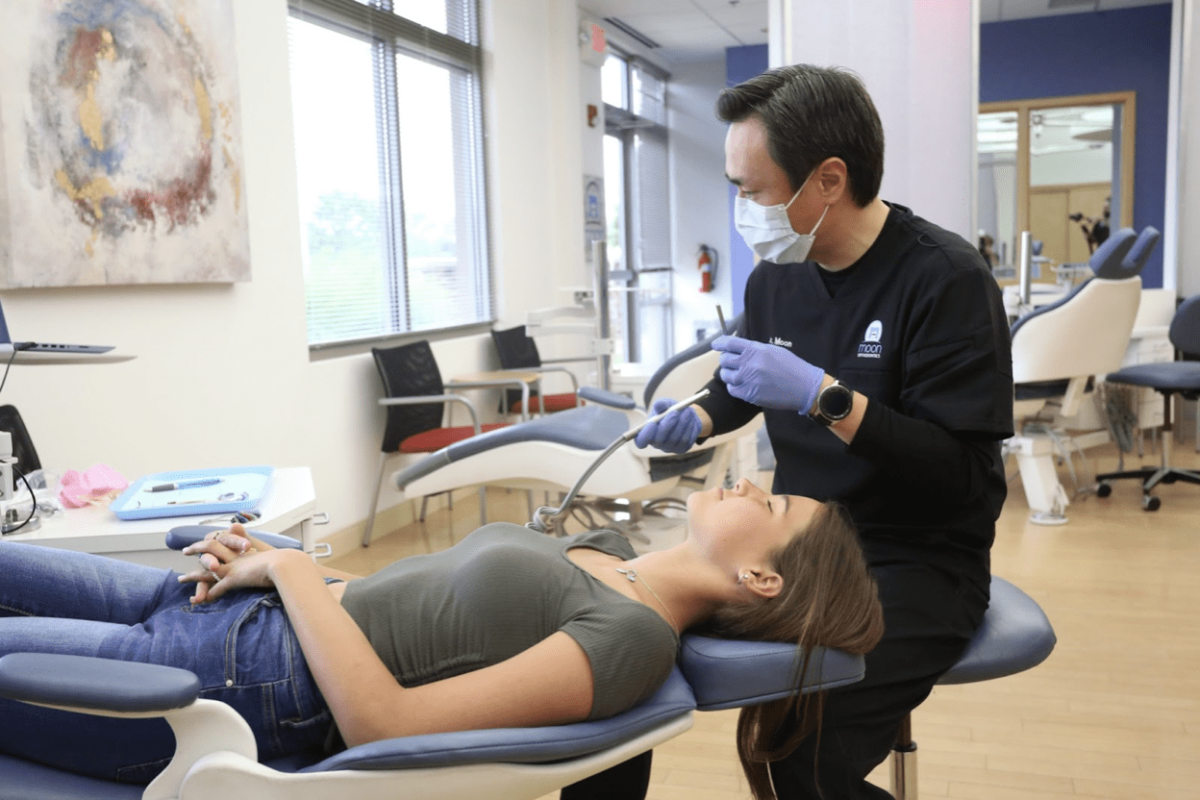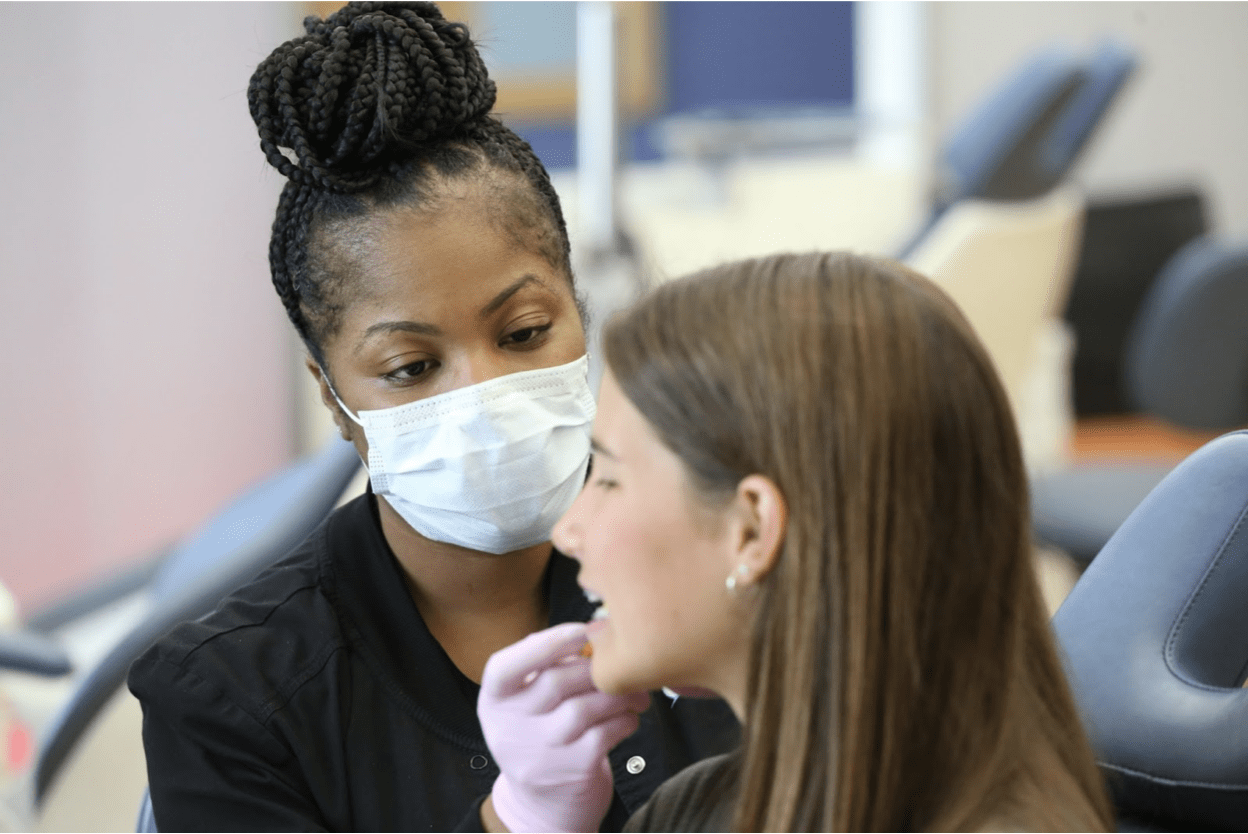Orthodontic treatment goes beyond what’s in your mouth. Did you know that sleeping problems can be addressed and treated by your orthodontic team? Moon Orthodontics wants you to get your best night’s sleep, and our experienced team has the skills to help you rest easy. Let’s take a look at how orthodontics can help you improve your sleeping patterns.
What’s TMJ? Is it the same thing as TMD?
These two abbreviations are often used interchangeably, even by some professionals. However, they mean two different things. TMJ stands for the temporomandibular joint. These are the hinge points that connect your jawbones to your head. This mobile joint is located directly in front of the ears, rotating and gliding while acting as a powerful hinge at the same time. This mobility allows you the ability to do things like speak, yawn, and chew your food properly.
The TMJ is surrounded by several complex protectors like muscles, tendons, and joint pads. These components work together most of the time, but if anything obstructs them, the result is a range of symptoms. That’s where TMD comes in. Temporomandibular disorders are a group of conditions that involve issues with your TMJ and the facial muscles that control its movement. Symptoms of these disorders can flare up in any interconnected parts of your upper body, including your jaw, ears, nose, face, neck, shoulders, and upper back. These often include:
- Backaches
- Persistent headaches
- Pain or tenderness in the jaw, face, or neck
- Clicking, popping or grating sounds in your jaw
- Jaws that get locked in an open or closed position
- Decreased jaw mobility and trouble opening your mouth fully
If you or a loved one has been experiencing any of these symptoms, we encourage you to schedule a consultation with us to get a proper diagnosis and discuss the available treatment options.
How can TMD affect your sleep?
Many patients with TMD experience discomfort while they are sleeping. Recent studies have even revealed a link between TMD and sleep apnea, which occurs when the airway becomes obstructed as a person is sleeping. When oxygen is cut off, your brain signals the information to your heart to keep beating, causing the person to gasp or choke for breath. This process can repeat hundreds of times per night, all the while interrupting your sleep. While it’s uncommon for people to awaken during an episode of apnea entirely, the disruption is often enough to disrupt your sleeping patterns.
Sleep apnea can be caused by a misaligned jaw joint causing the tongue to block the airway at night. In this case, treating TMD can treat sleep apnea! Bruxism, or teeth grinding, occurs when your jaw muscles clench, exerting pressure on the teeth, jaw, and joints. Teeth grinding can exacerbate the joints and teeth damage and may even wake you from a sound sleep at times.
TMD symptoms can be worsened by certain sleeping positions too. Sleeping on your side without proper head and neck support can pressure the jaw joint, causing headaches and pain upon waking. If you sleep with your arms above your head, it can increase strain in the shoulder area. According to TMD experts, the best sleeping position is on your back. This is because it reduces tension by keeping the spine in a neutral position.
TMJ/TMD
Your temporomandibular joints connect your lower jawbone to your skull. You use these joints throughout your day when you speak, chew, and swallow. Pain in and around these joints can be unpleasant and may even restrict movement. However, not all jaw pain is associated with TMD. If you notice any pain in addition to ear ringing, head, and neck aches, clicking or popping sounds in your jaw, muscle spasms, alignment changes, or lockjaw, tell Dr. Moon at your next appointment. We can help determine if you have TMD and create a personalized treatment plan to help relieve your symptoms.
Most people get TMD without ever having braces. Symptoms can come and go regardless of whether braces are worn, but there are solutions if you find yourself experiencing any issues. If you do not have TMD, there are many different preventative steps you can take to maintain a healthy, comfortable smile.
-
Avoid all gum chewing
-
Avoid grinding your teeth
-
Relax your face – “Lips together, teeth apart.”
-
Do not sit with your chin rested on your hand
-
Chew foods even on both sides of your mouth
-
Do not cradle the phone receiver between your head and shoulder
-
Practice good posture – keep your head up, back straight, and shoulders squared
What are the treatment options for TMD?
Fortunately, many people with TMD will experience minor symptoms that generally resolve on their own within a few weeks or months. During this time, you can ease symptoms by:
- Eating softer foods
- Taking smaller bites of food
- Applying ice or moist heat to the affected area
- Avoiding extreme jaw movements like wide yawning
- Alternating chewing on each side of your mouth
- Exploring gentle stress-relief techniques
TMD can happen due to arthritis, injury, or an imbalance in the nerves, ligaments, and muscles. It’s important to receive a proper diagnosis before you decide what to do next. This is why our doctors will conduct a thorough TMJ examination if you’re showing any symptoms. Dr. Moon will assess the cause and diagnose TMD, and then our team will develop a personalized treatment plan to help alleviate your discomfort. We take a rigorous multidisciplinary approach to using less invasive treatments.
These non-invasive treatments will not cause any permanent changes to the structure or position of your jaw or teeth. Even patients with more severe TMD symptoms won’t need aggressive treatment. TMD treatment options may include oral appliances like custom-made mouthguards combined with physical therapy, trigger point injections, or injections with botulinum toxin. We recommend orthodontic treatment like braces or Invisalign clear aligners if you need your bite corrected to minimize or eliminate TMD symptoms.
Are there other orthodontic treatment options besides braces?
Everyone has different needs when it comes to addressing their sleeping problems. We can utilize more than just traditional metal braces for some mouth and jaw issues that are disrupting your sleep. There are other options available if you want something different than braces.
A Rapid Palate Expander, or RPE, is a device placed on the roof of your mouth and used to widen the upper jaw. This option is used as a treatment for children since their mouths and palate are still not fully formed and can easily be manipulated. If a child’s mouth is not wide enough to accommodate the adult teeth, this RPE can be used without braces to provide spacing support for those teeth to properly grow in. This palate expander creates space allowing better airflow through the mouth, helping ease or prevent sleep apnea.
Another option is using custom oral appliances to help keep your jaw in a forward position and keep airflow undisrupted. There are two different methods of custom oral therapy with only slight differences. The first option is a tongue retaining mouthpiece, which has an extra piece to help position your tongue correctly. The second option is the mandibular advancement device which moves your lower jaw forward and tightens the soft tissues of the upper airway, preventing airway obstruction.
Get the most from your smile at Moon Orthodontics
You deserve the right care on the road to your ideal smile. With the right orthodontists to guide you through the right treatment, better confidence is right around the corner. If you have any questions or concerns about oral hygiene during treatment, our expert team is always here to help set your mind at ease. Are you interested in learning more about being proactive with your smile? Get in touch with us today to schedule a FREE consultation or follow-up appointment with our Overland Park or Olathe office!
 Free Consult
Free Consult


